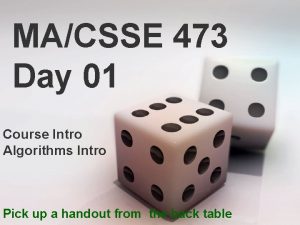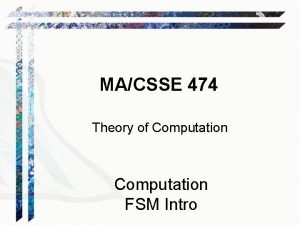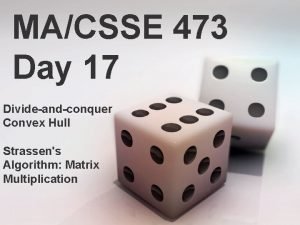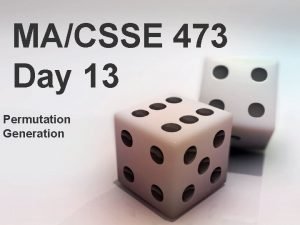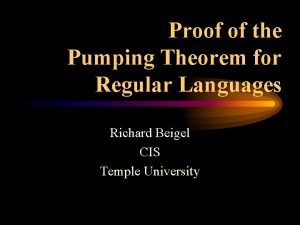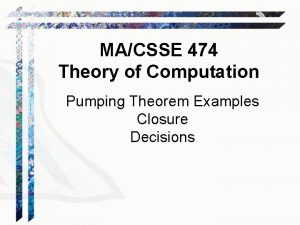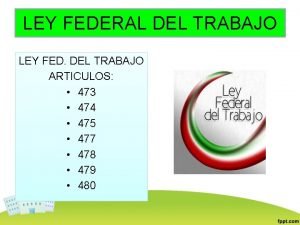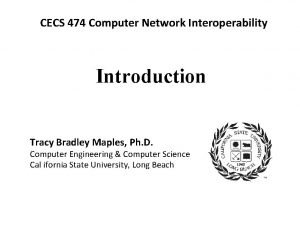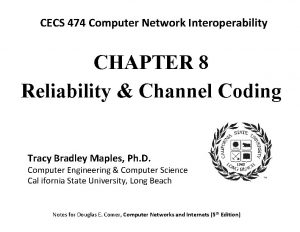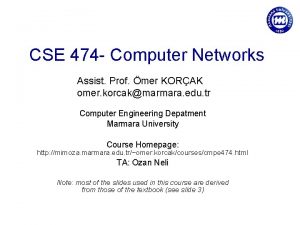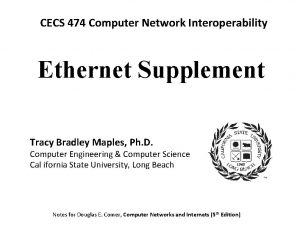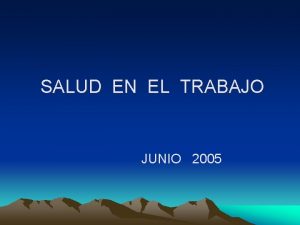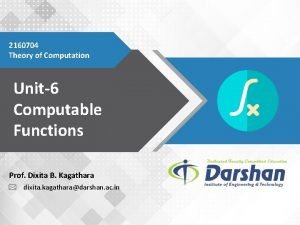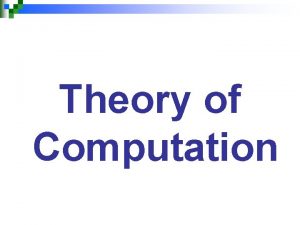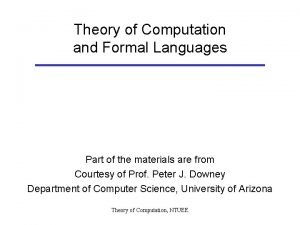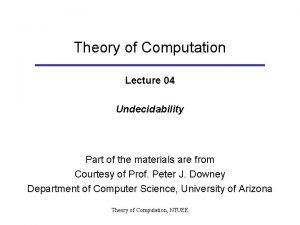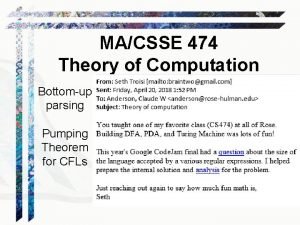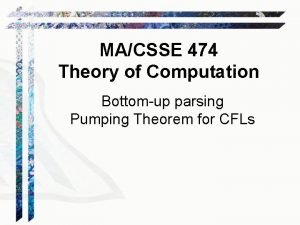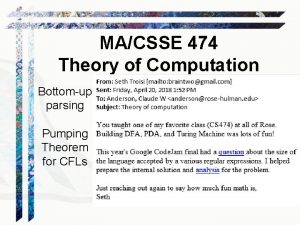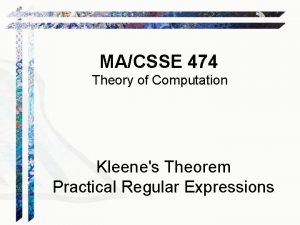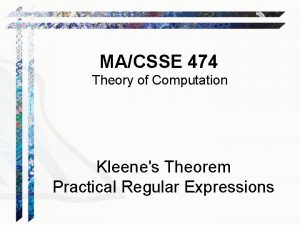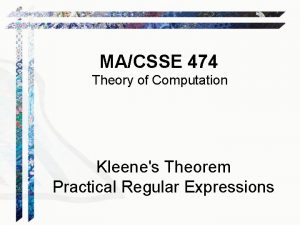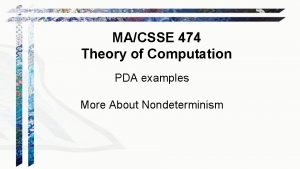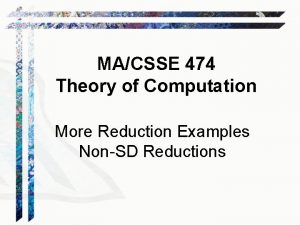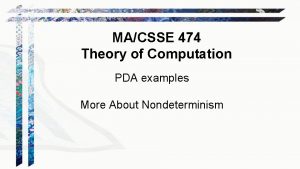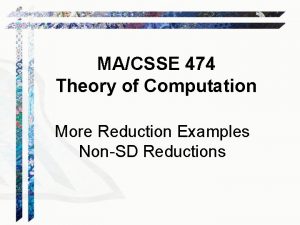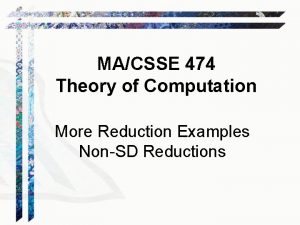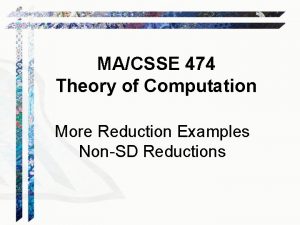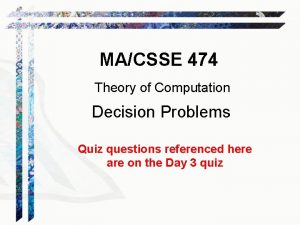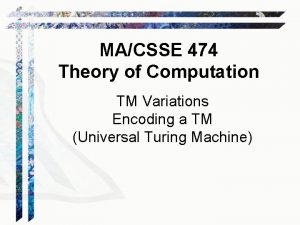MACSSE 474 Theory of Computation Pumping Theorem Examples

















- Slides: 17

MA/CSSE 474 Theory of Computation Pumping Theorem Examples

Your Questions? • Previous class days' material • Reading Assignments • HW 12 or 13 problems • Anything else

The Context-Free Pumping Theorem Write it in contrapositive form. Try to do this before going on. If L is a context-free language, then k 1 ( strings w L, where |w| k ( u, v, x, y, z (w = uvxyz, vy , |vxy| k, and q 0 (uvqxyqz is in L)))).

Pumping Theorem contrapositive • We want to write it in contrapositive form, so we can use it to show a language is NOT context-free. Original: If L is a context-free language, then k 1 ( strings w L, where |w| k ( u, v, x, y, z (w = uvxyz, vy , |vxy| k, and q 0 (uvqxyqz is in L)))). Contrapositive: If k 1 ( string w L, where |w| k ( u, v, x, y, z (w = uvxyz, vy , |vxy| k, and q 0 (uvqxyqz is not in L)))), then L is not a CFL.

Regular vs. CF Pumping Theorems Similarities: ● We don't get to choose k. ● We choose w, the string to be pumped, based on k. ● We don't get to choose how w is broken up (into xyz or uvxyz) ● We choose a value for q that shows that w isn’t pumpable. ● We may apply closure theorems before we start. Things that are different in CFL Pumping Theorem: ● Two regions, v and y, must be pumped in tandem. ● We don’t know anything about where in the strings v and y will fall in the string w. All we know is that they are reasonably “close together”, i. e. , |vxy| k. ● Either v or y may be empty, but not both.

An Example of Pumping: An. Bn. Cn = {anbncn, n 0} Choose w = ak bk ck (we don't get to choose the k) 1 | 2 | 3 (the regions: all a's, all b's, all c's) If either v or y spans two regions, then let q = 2 (i. e. , pump in once). The resulting string will have letters out of order and thus not be in An. Bn. Cn. Other possibilities for (v region, y region) (1, 1): q=2 gives us more a's than b's or c's. (2, 2) and (3, 3) similar. (1, 2): q=2 gives more a's and b's than c's. (2, 3) is similar. (1, 3): Impossible because |vxy| must be k.

An Example of Pumping: { L = { , n 0} The elements of L: n w 0 1 a 1 2 a 4 3 a 9 4 a 16 5 a 25 6 a 36 , n 0}

Nested and Cross-Serial Dependencies Pal. Even = {ww. R : w {a, b}*} a a b b a a The dependencies are nested. Context-free. Wc. W = {wcw : w {a, b}*} a a b c a a b Cross-serial dependencies. Not context-free.

Work with one or two other students on these • {anbman, n, m 0 and n m} • Wc. W = {wcw : w {a, b}*} • {(ab)nanbn : n > 0} • {xcy : x, y {0, 1}* and x y}

Halting It is possible that a PDA may ● not halt, ● never finish reading its input. Let = {a} and consider M = L(M) = {a}: (1, a, ) |- (2, a, a) |- (3, , ) On any other input except a: ● M will never halt. ● M will never finish reading its input unless its input is .

Nondeterminism and Decisions 1. There are context-free languages for which no deterministic PDA exists. 2. It is possible that a PDA may ● not halt, ● not ever finish reading its input. ● require time that is exponential in the length of its input. 3. There is no PDA minimization algorithm. It is undecidable whether a PDA is minimal.

Solutions to the Problem ● For NDFSMs: ● Convert to deterministic, or ● Simulate all paths in parallel. ● For NDPDAs: ● No general solution. ● Formal solutions usually involve changing the grammar. ● Such as Chomsky or Greibach Normal form. ● Practical solutions: ● Preserve the structure of the grammar, but ● Only work on a subset of the CFLs. ● LL(k), LR(k) (compilers course)

Closure Theorems for Context-Free Languages The context-free languages are closed under: ● Union ● Concatenation Let G 1 = (V 1, R 1, S 1), and G 2 = (V 2, R 2, S 2) generate languages L 1 and L 2 ● Kleene star ● Reverse Formal details on next slides; we will do them informally

Closure Under Union Let G 1 = (V 1, R 1, S 1), and G 2 = (V 2, R 2, S 2). Assume that G 1 and G 2 have disjoint sets of nonterminals, not including S. Let L = L(G 1) L(G 2). We can show that L is CF by exhibiting a CFG for it: G = (V 1 V 2 {S}, 1 2, R 1 R 2 {S S 1, S S 2}, S)

Closure Under Concatenation Let G 1 = (V 1, R 1, S 1), and G 2 = (V 2, R 2, S 2). Assume that G 1 and G 2 have disjoint sets of nonterminals, not including S. Let L = L(G 1)L(G 2). We can show that L is CF by exhibiting a CFG for it: G = (V 1 V 2 {S}, 1 2, R 1 R 2 {S S 1 S 2}, S)

Closure Under Kleene Star Let G = (V, , R, S 1). Assume that G does not have the nonterminal S. Let L = L(G)*. We can show that L is CF by exhibiting a CFG for it: G = (V 1 {S}, 1, R 1 {S , S S S 1}, S)

Closure Under Reverse LR= {w * : w = x. R for some x L}. Let G = (V, , R, S) be in Chomsky normal form. Every rule in G is of the form X BC or X a, where X, B, and C are elements of V - and a . ● X a: L(X) = {a}. ● X BC: L(X) = L(B)L(C). {a}R = {a}. (L(B)L(C))R = L(C)RL(B)R. Construct, from G, a new grammar G , such that L(G ) = LR: G = (VG, G, R , SG), where R is constructed as follows: ● For every rule in G of the form X BC, add to R the rule X CB. ● For every rule in G of the form X a, add to R the rule X a.
